How to decide which hands to 3-bet preflop
In poker, a preflop 3-bet is a highly profitable move that allows you to increase the pot and maximize your profits.
To assess how profitable a preflop 3-bet is, let’s filter this situation in Hand2Note 4 and look at the Action Profit indicator:
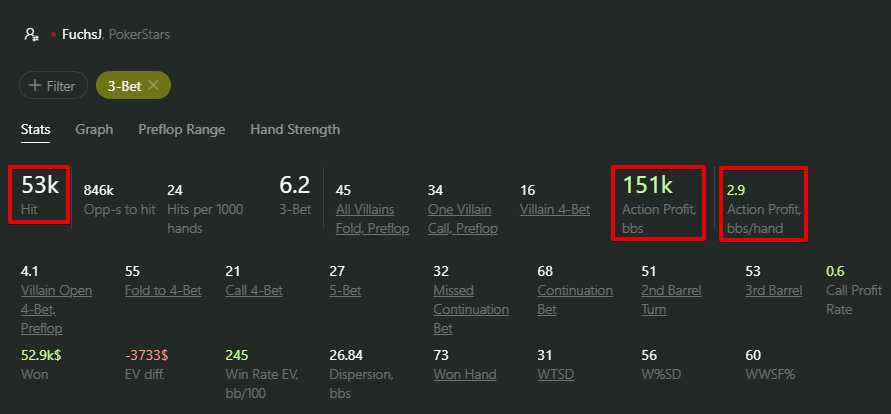
On the screenshot, we can see that throughout all my hands played, I’ve made 53k preflop 3-bets, resulting in the total profit of 151k big blinds in this scenario. Therefore, on average, each 3-bet earns me 2.9 big blinds per hand.
This is how it looks on the graph:

However, to use a 3-bet preflop in the most effective way, it’s important to take into account all the surrounding factors and analyze the playing style of your opponents.
In this article, we will discuss when to 3-bet preflop with premium hands, when it’s better to just call with them, and also examine 3-bets with medium-strength hands and bluff 3-bets.
Table of Contents:
3-Betting with Medium-Strength Hands
# 3-Betting with Premium Hands
Premium hands in No-Limit Texas Hold’em include high pocket pairs like AA, KK, and QQ, as well as the hand AK.
With such hands, a 3-bet should be your standard action, especially at micro-limits. Why? Because often players are not inclined to fold to a 3-bet and will call with hands that you dominate, such as JJ, TT, AQ, and AJ. This allows you to play a large pot with a very strong hand.
Many novice players like to call with premium hands preflop, trying to outplay their opponents and mask their monster hand. But in reality, straightforwardly playing these hands as a 3-bet will often be more profitable.
Let’s compare the values of Action Profit between a 3-bet and calling with premium hands.

We can see that, on average, a 3-bet with these hands brings me 6.9 big blinds per hand, whereas a call yields only 2.4 big blinds, which is almost three times less. Therefore, there needs to be very compelling reasons to forego a preflop 3-bet with one of these strong hands in favor of just calling.
# Calling with premium hands
However, there are situations where calling with a premium hand might be more advantageous than a 3-bet. If the player who made the initial raise is aggressive post-flop but frequently folds to preflop 3-bets, it makes sense to slow-play with an extremely strong hand and simply call to extract more bets on later streets. This would be more profitable than taking down a small pot by making a 3-bet.
Also, if there’s been a raise in front of you and there’s a highly aggressive player behind you who frequently inflates pots preflop, then calling with a monster hand can be very profitable. Such a play allows you to build a larger pot by playing the hand in the most advantageous way.
Let’s consider a suitable situation for slow-playing with a premium hand:
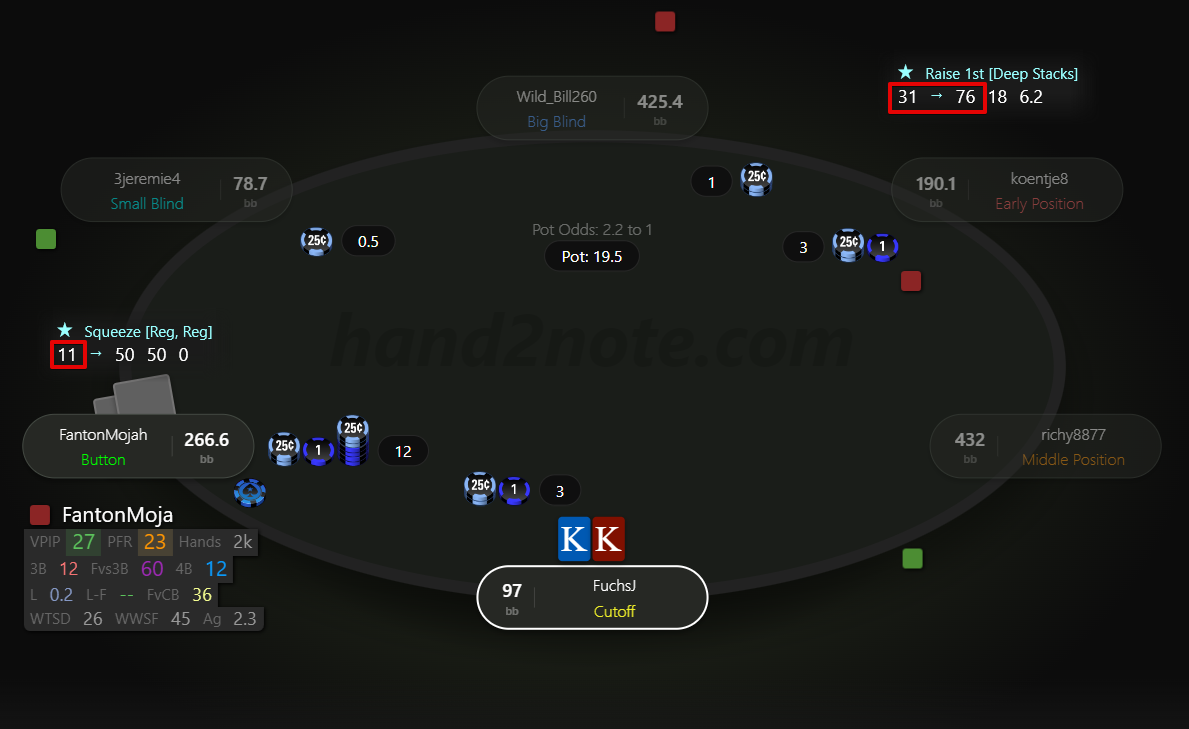
We were dealt pocket kings at the Cutoff position, and a player in an early position opened with a raise. By default, I would always 3-bet with KK, but in this particular situation, the dynamic HUD (Heads-Up Display) of Hand2Note 4 allows us to make a more profitable decision.
Firstly, we see that the Raise 1st stat of the early-position player is 31%, indicating a wide range of hands. Then, when facing a 3-bet, this player folds 76% of the time, so if we 3-bet, we will likely get a fold.
Secondly, there’s an aggressive player with a high squeeze (Sqz) stat of 11% sitting on the Button behind us.
Therefore, I decided to simply flat call with the kings. Predictably, the Button player made a squeeze, and the initial raiser folded. Then, I made another raise, ultimately winning a larger pot.
Of course, it’s easy and pleasant to play premium hands, but there’s one problem: they will be dealt to us very rarely. So, what other hands are suitable for a 3-bet?
# 3-betting with medium-strength hands
In addition to premium hands, we can 3-bet with medium-strength hands. This range includes pocket pairs JJ-99 and strong high cards such as AQ and AJ, as well as KQ suited.
A linear 3-betting range might look like this:

This approach is effective against opponents who:
● Open too many hands preflop.
The wider the range with which our opponent raises, the wider our linear 3-bet range should be.
● Often call 3-bets.
Since our 3-betting range consists only of strong hands, we will often be in a good shape against the range our opponent will call our 3-bet with.
● Rarely make 4-bets.
If our opponent rarely makes 4-bets, such a strong action from them will indicate a premium hand. Against such an opponent, we can continue 3-betting linearly, folding our weakest hands when facing their 4-bet.
Let’s consider a situation where 3-betting with a medium-strength hand would be profitable.
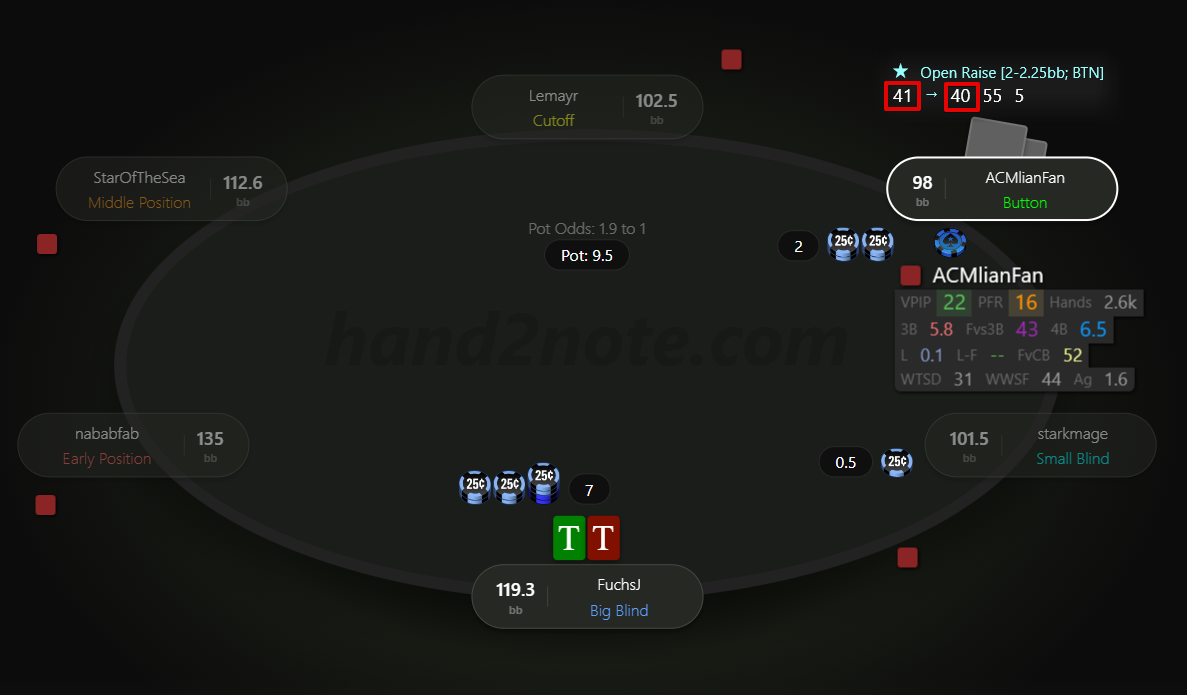
We are at the Big Blind with pocket tens, and the player in front of us has raised from the Button position. We can play cautiously and simply call or we can make a 3-bet. To make an optimal decision, let’s examine our opponent’s statistics.
In the HUD, we see that our opponent’s Button open raise percentage is 41%, and that this player folds only 40% of the time to a 3-bet, which indicates that most likely he won’t fold to our 3-bet.
Using Hand2Note 4, we can also see the specific hands with which our opponent opens from each position, helping us form a better understanding of their range.
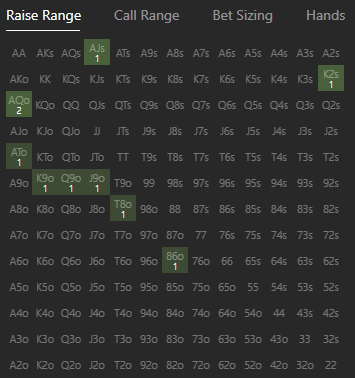
In the preflop matrix, we can see that this player’s opening range on the Button includes marginal hands like K2s, J9o, 86o, and so on.
Against such a range, a pair of tens performs very well, and I would definitely prefer to make a 3-bet. If our opponent folds, it would be a good outcome for us because we have just tens, not aces, but even if we get called, we will often have the better hand.
# Bluff 3-bets
Against some players, it will be profitable to add bluffs to premium hands in the 3-betting range.
For bluffs, it’s better to choose suited and connected hands, which can hit the flop and have the potential to make a strong combination, for example, hands like A5, A4, or T9, 98 suited.
An example of a polarized 3-betting range.

This 3-betting strategy works well against opponents who:
● Frequently fold to 3-bets.
Of course, when making a 3-bet with premium hands, we would like to get a call from our opponent, but with bluffs, we would be happy if they fold.
● Often fold to a continuation bet (c-bet) in a 3-bet pot on the flop.
If the initial raiser is reluctant to fold to a 3-bet but then frequently folds on the flop, a polarized 3-bet strategy will still be very profitable because even without hitting the flop, we will often take the pot by making a continuation bet on the flop.
● Frequently make 4-bets.
With a polarized 3-bet range, it is very simple to play against an opponent’s 4-bet: we will go all-in with our premium hands and easily fold our bluff hands.
Let’s consider an example of a suitable situation for a bluff 3-bet.
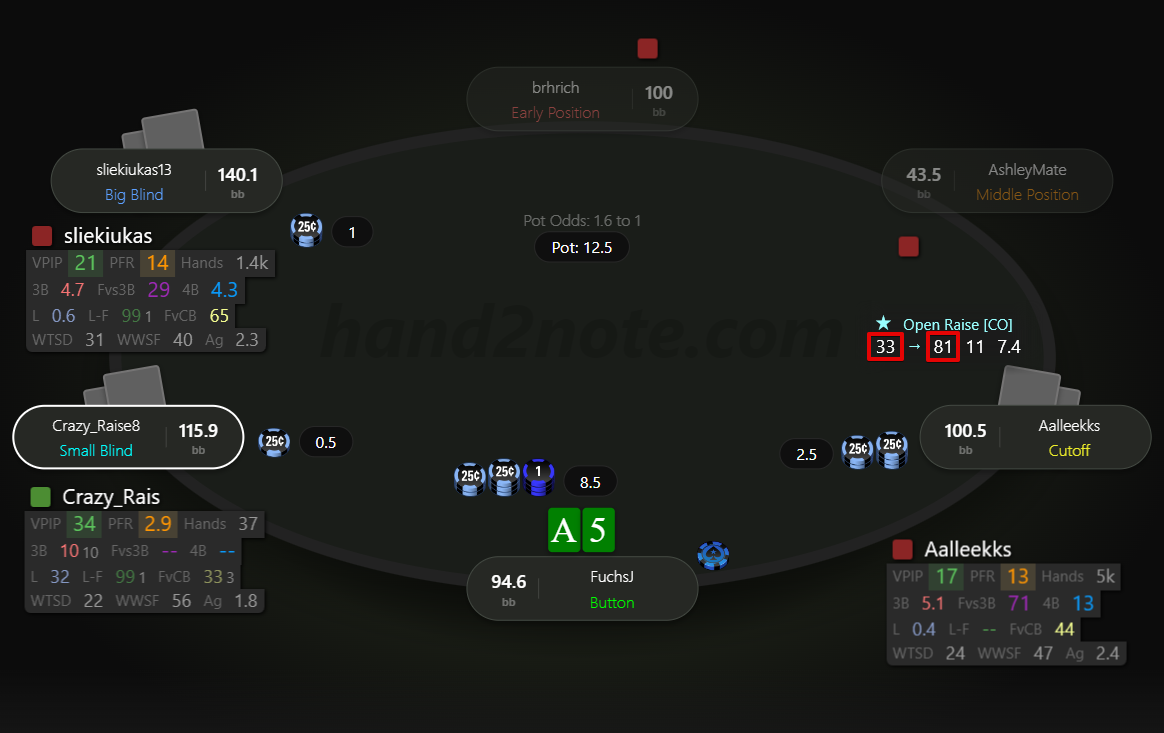
The player at the Cutoff made a raise, and we have A5 suited on the Button. Calling with such a hand wouldn’t be a bad play, but against our opponent, it’s an excellent hand for a bluff 3-bet.
In Hand2Note 4 dynamic HUD, we can see that this player’s open-raising frequency from the Cutoff position is 33%. It doesn’t seem like a very wide range, but notably, when facing a 3-bet, our opponent folded 81% of the time.
Seeing such statistics, we can confidently make a 3-bet even without looking at our hole cards, and it will still be profitable.
It’s important to remember that the choice of a 3-bet strategy should be based on the opponent’s characteristics and the context of the situation.
With Hand2Note 4, you’ll be able to easily determine the playing style of your opponents, understand their ranges, and exploit them with preflop 3-bets.
# How to decide which hands to 3-bet preflop
In poker, a preflop 3-bet is a highly profitable move that allows you to increase the pot and maximize your profits.
To assess how profitable a preflop 3-bet is, let’s filter this situation in Hand2Note 4 and look at the Action Profit indicator:

On the screenshot, we can see that throughout all my hands played, I’ve made 53k preflop 3-bets, resulting in the total profit of 151k big blinds in this scenario. Therefore, on average, each 3-bet earns me 2.9 big blinds per hand.
This is how it looks on the graph:

However, to use a 3-bet preflop in the most effective way, it’s important to take into account all the surrounding factors and analyze the playing style of your opponents.
In this article, we will discuss when to 3-bet preflop with premium hands, when it’s better to just call with them, and also examine 3-bets with medium-strength hands and bluff 3-bets.
Table of Contents:
3-Betting with Medium-Strength Hands
# 3-Betting with Premium Hands
Premium hands in No-Limit Texas Hold’em include high pocket pairs like AA, KK, and QQ, as well as the hand AK.
With such hands, a 3-bet should be your standard action, especially at micro-limits. Why? Because often players are not inclined to fold to a 3-bet and will call with hands that you dominate, such as JJ, TT, AQ, and AJ. This allows you to play a large pot with a very strong hand.
Many novice players like to call with premium hands preflop, trying to outplay their opponents and mask their monster hand. But in reality, straightforwardly playing these hands as a 3-bet will often be more profitable.
Let’s compare the values of Action Profit between a 3-bet and calling with premium hands.

We can see that, on average, a 3-bet with these hands brings me 6.9 big blinds per hand, whereas a call yields only 2.4 big blinds, which is almost three times less. Therefore, there needs to be very compelling reasons to forego a preflop 3-bet with one of these strong hands in favor of just calling.
# Calling with premium hands
However, there are situations where calling with a premium hand might be more advantageous than a 3-bet. If the player who made the initial raise is aggressive post-flop but frequently folds to preflop 3-bets, it makes sense to slow-play with an extremely strong hand and simply call to extract more bets on later streets. This would be more profitable than taking down a small pot by making a 3-bet.
Also, if there’s been a raise in front of you and there’s a highly aggressive player behind you who frequently inflates pots preflop, then calling with a monster hand can be very profitable. Such a play allows you to build a larger pot by playing the hand in the most advantageous way.
Let’s consider a suitable situation for slow-playing with a premium hand:

We were dealt pocket kings at the Cutoff position, and a player in an early position opened with a raise. By default, I would always 3-bet with KK, but in this particular situation, the dynamic HUD (Heads-Up Display) of Hand2Note 4 allows us to make a more profitable decision.
Firstly, we see that the Raise 1st stat of the early-position player is 31%, indicating a wide range of hands. Then, when facing a 3-bet, this player folds 76% of the time, so if we 3-bet, we will likely get a fold.
Secondly, there’s an aggressive player with a high squeeze (Sqz) stat of 11% sitting on the Button behind us.
Therefore, I decided to simply flat call with the kings. Predictably, the Button player made a squeeze, and the initial raiser folded. Then, I made another raise, ultimately winning a larger pot.
Of course, it’s easy and pleasant to play premium hands, but there’s one problem: they will be dealt to us very rarely. So, what other hands are suitable for a 3-bet?
# 3-betting with medium-strength hands
In addition to premium hands, we can 3-bet with medium-strength hands. This range includes pocket pairs JJ-99 and strong high cards such as AQ and AJ, as well as KQ suited.
A linear 3-betting range might look like this:

This approach is effective against opponents who:
● Open too many hands preflop.
The wider the range with which our opponent raises, the wider our linear 3-bet range should be.
● Often call 3-bets.
Since our 3-betting range consists only of strong hands, we will often be in a good shape against the range our opponent will call our 3-bet with.
● Rarely make 4-bets.
If our opponent rarely makes 4-bets, such a strong action from them will indicate a premium hand. Against such an opponent, we can continue 3-betting linearly, folding our weakest hands when facing their 4-bet.
Let’s consider a situation where 3-betting with a medium-strength hand would be profitable.

We are at the Big Blind with pocket tens, and the player in front of us has raised from the Button position. We can play cautiously and simply call or we can make a 3-bet. To make an optimal decision, let’s examine our opponent’s statistics.
In the HUD, we see that our opponent’s Button open raise percentage is 41%, and that this player folds only 40% of the time to a 3-bet, which indicates that most likely he won’t fold to our 3-bet.
Using Hand2Note 4, we can also see the specific hands with which our opponent opens from each position, helping us form a better understanding of their range.

In the preflop matrix, we can see that this player’s opening range on the Button includes marginal hands like K2s, J9o, 86o, and so on.
Against such a range, a pair of tens performs very well, and I would definitely prefer to make a 3-bet. If our opponent folds, it would be a good outcome for us because we have just tens, not aces, but even if we get called, we will often have the better hand.
# Bluff 3-bets
Against some players, it will be profitable to add bluffs to premium hands in the 3-betting range.
For bluffs, it’s better to choose suited and connected hands, which can hit the flop and have the potential to make a strong combination, for example, hands like A5, A4, or T9, 98 suited.
An example of a polarized 3-betting range.

This 3-betting strategy works well against opponents who:
● Frequently fold to 3-bets.
Of course, when making a 3-bet with premium hands, we would like to get a call from our opponent, but with bluffs, we would be happy if they fold.
● Often fold to a continuation bet (c-bet) in a 3-bet pot on the flop.
If the initial raiser is reluctant to fold to a 3-bet but then frequently folds on the flop, a polarized 3-bet strategy will still be very profitable because even without hitting the flop, we will often take the pot by making a continuation bet on the flop.
● Frequently make 4-bets.
With a polarized 3-bet range, it is very simple to play against an opponent’s 4-bet: we will go all-in with our premium hands and easily fold our bluff hands.
Let’s consider an example of a suitable situation for a bluff 3-bet.

The player at the Cutoff made a raise, and we have A5 suited on the Button. Calling with such a hand wouldn’t be a bad play, but against our opponent, it’s an excellent hand for a bluff 3-bet.
In Hand2Note 4 dynamic HUD, we can see that this player’s open-raising frequency from the Cutoff position is 33%. It doesn’t seem like a very wide range, but notably, when facing a 3-bet, our opponent folded 81% of the time.
Seeing such statistics, we can confidently make a 3-bet even without looking at our hole cards, and it will still be profitable.
It’s important to remember that the choice of a 3-bet strategy should be based on the opponent’s characteristics and the context of the situation.
With Hand2Note 4, you’ll be able to easily determine the playing style of your opponents, understand their ranges, and exploit them with preflop 3-bets.















